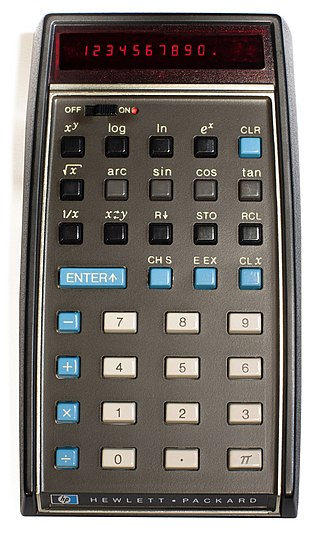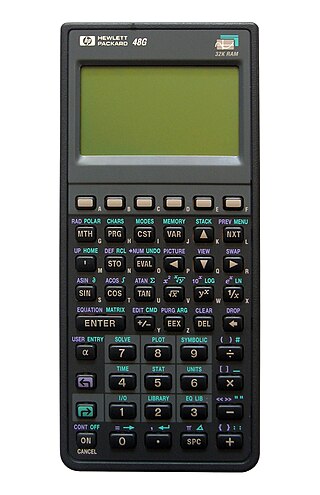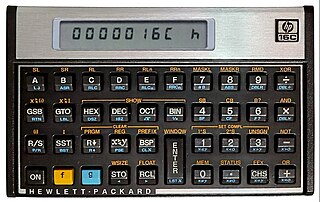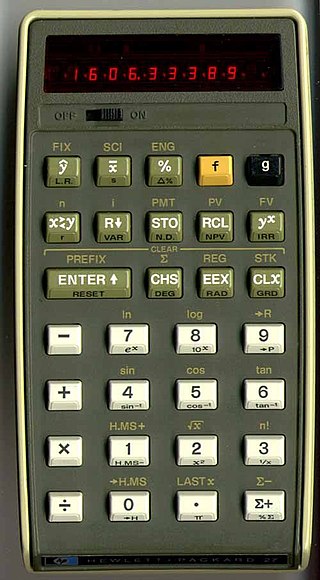
An electronic calculator is typically a portable electronic device used to perform calculations, ranging from basic arithmetic to complex mathematics.

Reverse Polish notation (RPN), also known as reverse Łukasiewicz notation, Polish postfix notation or simply postfix notation, is a mathematical notation in which operators follow their operands, in contrast to prefix or Polish notation (PN), in which operators precede their operands. The notation does not need any parentheses for as long as each operator has a fixed number of operands.

The HP-35 was Hewlett-Packard's first pocket calculator and the world's first scientific pocket calculator: a calculator with trigonometric and exponential functions. It was introduced in 1972.

The HP-65 is the first magnetic card-programmable handheld calculator. Introduced by Hewlett-Packard in 1974 at an MSRP of $795, it featured nine storage registers and room for 100 keystroke instructions. It also included a magnetic card reader/writer to save and load programs. Like all Hewlett-Packard calculators of the era and most since, the HP-65 used Reverse Polish Notation (RPN) and a four-level automatic operand stack.

The HP 33s (F2216A) was a scientific calculator marketed by Hewlett-Packard. It was introduced in 2003 as the successor to the HP 32SII, and discontinued on the introduction of its successor the HP 35s in 2007.

The HP-20S (F1890A) is an algebraic programmable scientific calculator produced by Hewlett-Packard from 1987 to 2000.
Engineering notation or engineering form (also technical notation) is a version of scientific notation in which the exponent of ten is always selected to be divisible by three to match the common metric prefixes, i.e. scientific notation that aligns with powers of a thousand, for example, 531×103 instead of 5.31×105 (but on calculator displays written without the ×10 to save space). As an alternative to writing powers of 10, SI prefixes can be used, which also usually provide steps of a factor of a thousand. On most calculators, engineering notation is called "ENG" mode as scientific notation is denoted SCI.

HP calculators are various calculators manufactured by the Hewlett-Packard company over the years.

The Hewlett-Packard Voyager series of calculators were introduced by Hewlett-Packard in 1981. All members of this series are programmable, use Reverse Polish Notation, and feature continuous memory. Nearly identical in appearance, each model provided different capabilities and was aimed at different user markets.

The HP-25 was a hand-held programmable scientific/engineering calculator made by Hewlett-Packard between early January 1975 and 1978. The HP-25 was introduced as a cheaper alternative to the ground-breaking HP-65.

The HP-19C and HP-29C were scientific/engineering pocket calculators made by Hewlett-Packard between 1977 and 1979. They were the most advanced and last models of the "20" family and included Continuous Memory as a standard feature.

The HP-15C is a high-end scientific programmable calculator of Hewlett-Packard's Voyager series produced between 1982 and 1989.

The HP-16C Computer Scientist is a programmable pocket calculator that was produced by Hewlett-Packard between 1982 and 1989. It was specifically designed for use by computer programmers, to assist in debugging. It is a member of the HP Voyager series of programmable calculators. It was the only programmer's calculator ever produced by HP, though many later HP calculators have incorporated most of the 16C's functions.

The HP-28C and HP-28S were two graphing calculators produced by Hewlett-Packard from 1986 to 1992. The HP-28C was the first handheld calculator capable of solving equations symbolically. They were replaced by the HP 48 series of calculators, which grew from the menu-driven RPL programming language interface first introduced in these HP-28 series.

The HP-27 was a hand-held scientific and financial, but not programmable, calculator made by Hewlett-Packard between 1976 and 1978.

The HP 35s (F2215A) is a Hewlett-Packard non-graphing programmable scientific calculator. Although it is a successor to the HP 33s, it was introduced to commemorate the 35th anniversary of the HP-35, Hewlett-Packard's first pocket calculator. HP also released a limited production anniversary edition with shiny black overlay and engraving "Celebrating 35 years".

The HP 20b Business Consultant is a financial calculator published in 2008 by Hewlett-Packard. Its function is similar to HP 10bII and includes scientific and statistical functions.

The HP-67 is a magnetic card-programmable handheld calculator, introduced by Hewlett-Packard in 1976 at an MSRP of $450. A desktop version with built-in thermal printer was sold as the HP-97 at a price of $750. Collectively, they are known as the HP-67/97.

The HP-22 was a finance-oriented pocket calculator produced by Hewlett-Packard between 1975 and 1978. It was designed as a replacement for the short-lived HP-70, and was one of a set of three calculators, the others being the HP-21 and HP-25, which were similarly built but aimed at different markets.

The HP-30 or Spice series are RPN Scientific hand held calculators introduced by Hewlett-Packard in 1978. Some models are a programmable.



















